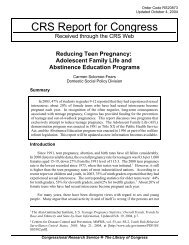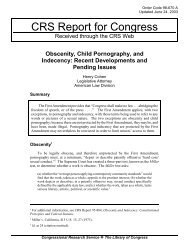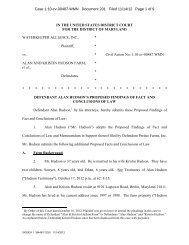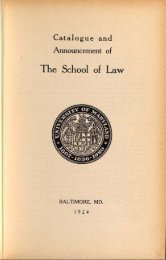journal - University of Maryland School of Law
journal - University of Maryland School of Law
journal - University of Maryland School of Law
You also want an ePaper? Increase the reach of your titles
YUMPU automatically turns print PDFs into web optimized ePapers that Google loves.
19901<br />
MONTREAL PROTOCOL<br />
fulfilled in light <strong>of</strong> accumulating scientific evidence suggesting that the<br />
problem <strong>of</strong> ozone depletion is worse that originally suspected.<br />
A. The Call for More Stringent Controls<br />
Surprisingly, it has been the European Community, and not the<br />
United States, that has stepped up the fight against ozone destruction<br />
following the signing <strong>of</strong> the Protocol. In early March <strong>of</strong> 1989, the<br />
twelve member nations <strong>of</strong> the European Community met in Brussels<br />
and agreed to an immediate eighty-five percent reduction with total<br />
elimination by the year 2000. Just days after the Brussels meeting, a<br />
conference sponsored by British Prime Minister Margaret Thatcher<br />
gathered representatives <strong>of</strong> 123 nations in London to discuss, among<br />
other things, extending the accelerated phaseout schedules to all <strong>of</strong> the<br />
treaty's signatories. 1 While this goal was not achieved in London, the<br />
EEC, the United States and Canada did vow to go beyond the Protocol's<br />
requirements and completely phaseout CFC use by the turn <strong>of</strong> the<br />
century .52<br />
The push for accelerated timetables however, has not met with<br />
universal acceptance. Third World countries, embarking upon economic<br />
developments that will necessarily involve large-scale dependence<br />
on industries that use CFCs, are simply not willing to forego<br />
growth they view as crucial. 5 3 According to the developing nations, it is<br />
the industrialized world, grown rich while creating the environmental<br />
crisis, that is most responsible for the current damage and capable <strong>of</strong><br />
bearing the burdens associated with CFC elimination. 4 There is also<br />
some suspicion on the part <strong>of</strong> developing nations that the call for steep,<br />
immediate cuts by the West is an attempt to prevent poorer nations<br />
51. Participants at the London meeting included China, India and the Soviet<br />
Union, countries constituting the most vocal and influential opponents <strong>of</strong> accelerated<br />
phaseout schedules. The EC's action apparently jolted the U.S. into action. Just days<br />
after the unscheduled Brussels conference, William K. Reilly, President Bush's new<br />
EPA Administrator, called for the United States to match the European plan to speed<br />
up the timetables for phaseout.<br />
52. President Bush, however, made it clear that the U.S. phaseout was conditioned<br />
on the development <strong>of</strong> adequate substitutes. Lemonick, First Aid for the Ozone<br />
Layer: The Movement to Ban CFC's is Starting to Roll, TIME, March 13, 1989, at 50.<br />
53. China for instance, has recently completed 12 CFC production plants. The<br />
need for the capacity is unquestionable. Although the country has a population <strong>of</strong> 1.1<br />
billion, fewer than 1 in 10 families have a refrigerator. Stammer, Saving the Earth:<br />
Who Sacrifices?, L. A. Times, March 13, 1989, at 1, col.6.<br />
54. Stevens, Ecological Threats, Rich-Poor Tensions, N. Y. Times, March 26,<br />
1989.















